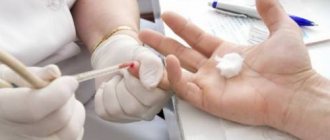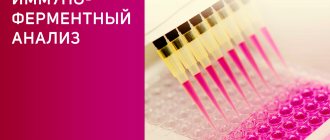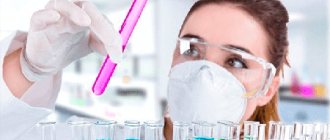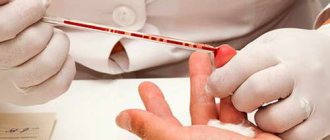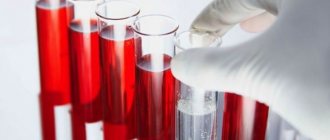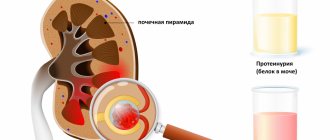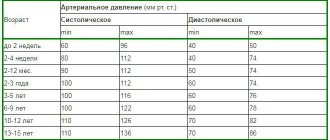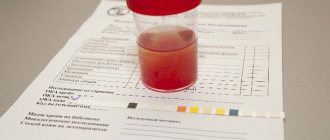Home > Encyclopedia of Oncology > What the tumor marker Ca 15-3 shows: decoding
Both when breast cancer is diagnosed and when this pathology is suspected, identifying the stage of the malignant process and determining the extent of the lesion play a huge role. One of the methods for obtaining reliable information about the patient’s condition is to analyze the mucin-type glycoprotein produced by the tumor. Women who are prescribed this study should know what the Ca 15-3 tumor marker shows in order to:
- realize the advisability of completing the procedure as soon as possible;
- dispel the misconception that elevated readings always indicate the presence of cancer;
- learn the specifics of interpretation and the importance of visiting a high-quality medical center;
- take measures to treat the detected disease without delay.
As with other blood tests, in order for the results and interpretation of the Ca 15-3 tumor marker to be accurate and reliable, the correct sequence of testing, modern equipment and proper preparation of the patient are needed. Israeli doctors, who have achieved enormous success in detecting mutated cells, can make a diagnosis at a very early stage. Thanks to an integrated approach, including laboratory and instrumental examinations, specialists assess the condition of the female body and prescribe appropriate therapy.
Characteristics of the antigen
Exceeding the norm of antigen content is characteristic of breast carcinomas. At the same time, it does not belong to the category of strictly specific, since in the first and second stages it is found in too large quantities in 1/5 of the subjects. The value of analysis as a diagnostic method is associated with its combination with CEA. If Ca 15-3 is elevated simultaneously with an increase in the norm of the tumor marker CEA, this means that the primary site of metastasis.
Interesting! The antigen is a protein compound weighing about 300 thousand Daltons and is characterized by a carbohydrate base, formed from epithelial cells of the mammary ducts.
When deciphered, the pathogenic protein content may be higher than normal not only in a patient with an advanced form of cancer, but also in healthy people or those whose cell mutation is at the initial stage.
In this regard, before making any diagnosis or prescribing therapy, especially surgical intervention or chemical treatment, women undergo additional research. In addition to ultrasound therapy, MRI and computed tomography, laboratory tests may also be required, for example, for the EMA marker. Consult an Israeli specialist
When to see a doctor
In the initial stages of breast cancer:
- Unusual formations are felt in the mammary gland. Very often the tumor can be small and not paid attention to.
- A characteristic feature of this structure is its painlessness. Most often, a growing cancer tumor in the initial stages does not cause concern.
- Areas with skin retraction are identified.
- In later stages of the disease, pain appears in the area where the tumor grows.
- A change in the nipple is detected, which thickens and swells.
- The nipple is retracted into the breast. In this case, you can look for a tumor in this area.
- Discharge from the nipple appears that is not associated with pregnancy or breastfeeding. Normally, the presence of minor discharge associated with changes in hormonal levels is acceptable. At the same time, the amount of discharge is insignificant and there are no blood impurities in them. In the presence of pathological changes, the amount of discharge increases sharply.
- There is an increase in the lymph nodes in the axillary region, they form a bunch of grapes.
- In case of advanced pathology, a blood test for tumor markers is carried out in the presence of the following symptoms:
- A tumor that is easily detected by palpation of the chest.
- Changing the location of the seal with a retracted nipple.
- Thickening of the skin around the nipple.
The signs of cancer are the same for all women; the symptoms that occur as the tumor grows may differ.
There are many forms of breast cancer, but they all have one common symptom - the appearance of enlarged lymph nodes in the armpit. If such a symptom is detected, contacting a doctor is mandatory. As a rule, when studying blood, even in normal conditions, an increase in the concentration of a tumor marker is detected.
At the discretion of the attending physician and in the presence of alarming symptoms, persons who are at risk for developing breast cancer and other pathologies are sent for a blood test:
- Patients whose families have already been diagnosed with breast cancer
- Women over forty years of age
- If the patient has been taking hormonal contraceptives for a long time
- Persons with atypical hyperplasia
- Patients with a persistent increase in estrogen levels in the blood
- Pregnant for the first time after thirty years
- Women suffering from long-term infertility
- Patients with a history of breast and ovarian cancer
- Women with late menopause
- Persons by occupation who come into contact with radioactive substances.
- How to get it back to normal
- If there are elevated tumor marker values in the blood, measures are taken to identify the reasons that led to the changes.
- When a diagnosis is made, a course of treatment is prescribed, which can be conservative or require surgical intervention. Upon completion of therapy, the level of antibodies drops to minimal values or specific proteins disappear completely.
Conservative treatment includes:
- Radiotherapy. Refers to the category of maintenance treatment. It is carried out before or after removal of the tumor. During the procedure, degenerated cells are destroyed.
- Intrabeam. Intraoperative irradiation. Radiation therapy is carried out during surgery, affecting the area where the tumor was located. In this case, the risk of damage to healthy tissue is significantly reduced and relapses of the disease are eliminated. The body's recovery period is reduced by six weeks.
- Chemotherapy. Which refers to medicinal methods. The patient is prescribed drugs of a toxic group that destroy mutated cells. They resort to a similar technique if surgical intervention is impossible. The result of the action of chemotherapy is the destruction of proteins responsible for the growth and division of cancer cells. In some cases, the DNA and RNA chains of diseased cells are destroyed.
- Hormone therapy is rarely used, only in situations where the tumor is susceptible to the influence of drugs belonging to this group.
- Targeted therapy is considered the mildest form of treatment for breast cancer, since the effect is exclusively on cancer cells. For this purpose, special drugs are prescribed.
Among the medications, patients are prescribed:
- Maximim in injections. The solution is administered intramuscularly daily for two weeks.
- Penicillin is prescribed when a diagnosis of fibrocystic mastopathy is established. In this case, an antibiotic is necessary to eliminate the symptom of inflammation and tissue swelling. The daily dose is two tablets.
- Tamoxifen, drug related to hormonal. Prescribed to restore hormonal levels. Which contributes to the disappearance of the tumor.
- Femoden. It also affects hormone levels. Under its influence, the tumor disintegrates.
Even after receiving a negative result, monitoring of the patient continues. She is prescribed preventive examinations and laboratory tests are carried out. Most often, such observation is carried out for life, since the likelihood of the disease returning remains.
Who is the analysis indicated for?
First of all, determination of the antigen level is necessary if breast cancer is suspected or an oncological diagnosis has already been made. Decoding the Ca 15-3 tumor marker is needed not only to confirm breast pathology in women, but also to clearly understand how badly the body is affected. Treatment tactics and, accordingly, survival prognosis depend on this. Israeli clinics, such as Assuta, have innovative equipment and qualified staff, which eliminates errors when performing tests.
Important! Many patients from post-Soviet countries with carcinoma are examined in Israel, after which it turns out that the diagnosis was made incorrectly in their homeland.
Thanks to the results, the doctor can understand whether it is worth talking about cancer or hormonal mastopathy. Also, blood sampling from a vein is necessary at the stage of completing a treatment and rehabilitation course for:
- detection of metastatic formations at the initial stage;
- tracking how effective the treatment plan is. In approximately 2/3 of patients, after the start of treatment, a significant decrease in antigen levels is observed, and the preservation of indicators indicates either the progression of the disease or active metastasis;
- timely adjustment of treatment in the absence of positive dynamics of indicators - if the norm of the tumor marker Ca 15-3 is still exceeded after surgery or chemotherapy, additional monitoring and changes in the tactics of influencing cancer cells may be prescribed;
- making an objective forecast.
How to determine
Chemiluminescence immunoassay is used to detect tumor markers in serum. This method is similar in its method to enzyme-linked immunosorbent assay. The essence of immunochemiluminescence research lies in the use of specific magnetic particles that have a high degree of sensitivity.
During the study of serum, immune reactions are detected combining a specific antigen with a specific antibody. Such reactions are unique, which makes it possible to prove with high accuracy the presence of pathological changes.
Plasma testing is carried out using an automatic chemiluminescence immunoassay analyzer.
The likelihood of receiving false data is low.
The cause of the error may be:
- incorrect actions of the laboratory assistant when drawing blood;
- failure of the patient to comply with the conditions of preparation for the examination.
For a more accurate diagnosis, an additional blood test for carcinoembryonic antigen is performed. If the test is negative and there are visible signs of breast cancer, the examination is repeated.
In the initial stages of pathology, the concentration of antigens may be low and specific proteins will not be detected by traditional laboratory tests. In this case, a repeat analysis is carried out after a short period of time.
Reasons for the increase in indicators
Although this marker is considered decisive for breast tumors, its results are not an unambiguous guarantee that there is a focus of epithelial cell mutation in the body. Among the cancers in which the tumor marker Ca 15-3 is elevated, it is worth noting:
- bronchogenic type carcinoma;
- malignant neoplasms of the cervix;
- breast cancer with metastases;
- hepatocellular tumors;
- ovarian damage;
- pancreatic oncology.
Non-oncological causes of abnormally high values may be:
- benign tumors;
- third trimester of pregnancy;
- hepatitis in chronic or acute stage;
- diseases of the endocrine system of an autoimmune nature;
- cirrhosis of the liver;
- endometriosis.
To understand what exactly a woman is sick with, you need an integrated approach to diagnosis, so it is advisable to use the services of a clinic that has not only its own laboratory, but also machines for MRI, CT and ultrasound.
Pregnancy test
There are a number of differences in what the tumor marker Ca 15-3 means in pregnant women. It is performed very carefully so as not to miss the pathogenic process at the initial stage of development. The assessment of quantitative values is identical to that used when interpreting non-pregnant women:
- the norm is considered to be a protein content in the blood of up to 20-25 units per milliliter;
- indicators of 30 U/ml are threshold;
- if a concentration of more than 30 Units per milliliter is detected;
- if the readings are above 50 U/ml, then we are most likely talking about oncology.
Interesting! In completely healthy women, the norm of the tumor marker Ca 15-3 ranges from 6.5 to 13.4 units per milliliter. But sometimes, even with normal values, the likelihood of cancer exists.
When examined in the last three months of gestation, the permissible values may be exceeded, therefore, in order to clarify the diagnosis, a number of other tests and procedures are done. In the absence of symptoms and normal results, medical observation and re-diagnosis after the birth of the child are indicated.
Dynamic observation
A single acquisition of information about the antigen content does not allow one to fully assess the likelihood of cancer or determine how a malignant neoplasm is being reduced. Therefore, most often the study of the ratio of results to the norm of the tumor marker Ca 15-3 is shown in dynamics. Similar tactics are used as part of systematic observation, in particular, when a woman is diagnosed with a benign tumor and the indicators are within the acceptable limit:
- During the first year, the biomaterial is examined monthly.
- For the second year, samples are taken every 2 months.
- Third year – once a quarter.
Such tracking makes it possible to understand at what point cells will begin to mutate and there is a risk of developing breast cancer.
Preparing and conducting analysis
Collecting material for research is a completely safe procedure. Its task is to obtain the most accurate result.
To do this, a number of conditions must be met:
- Blood sampling is carried out in the morning strictly on an empty stomach.
- The last meal should take place twelve hours before the examination.
- At the last meal, dishes containing large amounts of fat and spicy seasonings are completely excluded from the diet.
- A few days before the visit to the laboratory, the consumption of alcohol, alcohol-containing drinks, and energy drinks with high levels of caffeine is prohibited. These substances can affect the composition and condition of the blood.
- Smoking is prohibited for several hours prior to your visit to the laboratory.
- On the eve of the examination, avoid stress and limit the level of physical activity.
- For several days before the examination, it is recommended not to take medications, especially those that suppress the immune system, as well as drugs belonging to the group of corticosteroids and tranquilizers. An exception is made for essential medicines. Their name and dose must be indicated on the directions.
- If necessary, drinking still water before analysis is allowed.
- Receiving material
- The material is collected in a treatment room under highly sterile conditions.
- Blood is taken from the antecubital vein only by a medical professional.
- Minor discomfort may appear if the patient’s pain threshold is elevated.
What to do if the indicator is elevated
There are quite a lot of women who have high antigen levels and lumps in their breasts, and all of them are interested in correctly diagnosing their illness and maintaining health. To do this, first of all, you should undergo a comprehensive examination, and, according to reviews on the forums, for girls who have an elevated tumor marker 15-3, it is best to do this in Israel. Here they can count on the professionalism of doctors and the absence of violations of the testing and sample storage procedures. The list of necessary studies includes a biopsy (in the absence of contraindications) and mammography.
If the tumor is not malignant, then you need to undergo regular examinations by an oncologist and mammologist in the future. Then the moment of degeneration of a neoplasm into a malignant one will not be missed. Even with borderline values, one should not forget about visiting specialists, especially if there is an unfavorable family history and other factors contributing to the development of cancer, namely:
- the onset of menopause;
- previously had cancer (it does not matter which organ, although those who have recovered from breast cancer are at greater risk);
- infertility or late birth of the first child;
- early onset of menstruation.


